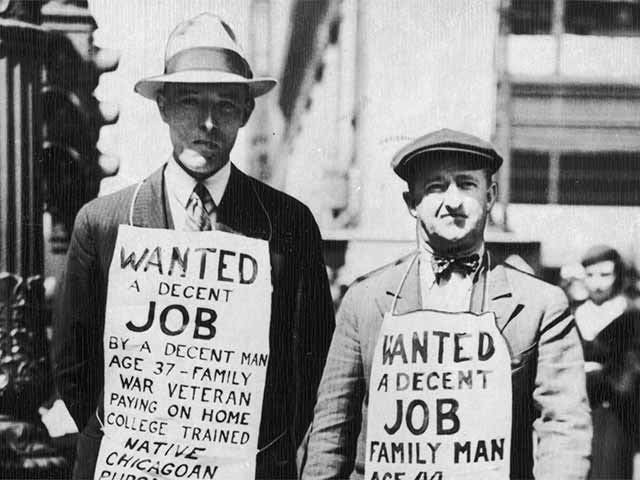
Mark Moncrieff
Between 1945 and 1975 in most of the Western world there existed a policy of full employment. What that exactly meant was different from country to country and at different times. In Australia it meant an unemployment rate of under 2% and long term unemployment being regarded as anything longer than 3 months. Most other countries had much the same aims.
The reason that full employment was such an issue was due to the Great Depression. It is hard at this distance for most people to understand just how traumatic those times were. It wasn’t just how hard life was, that people couldn’t afford to buy things or that men didn’t have jobs, it was the trauma. They had been told that hard work and following the rules were the correct way to live life.
During that time none of that mattered, good men lost their jobs and became destitute. A man had to send his wife and his children away so that they could live under someone else’s roof. And for him he had to join the soup kitchen or become a tramp and travel from place to place to try to gain any work he could.
Those people who did not become destitute knew that it could happen to them. They had to bring in family members and house them and feed them. Housewives would get men knocking on the door asking for food and asking for work, chopping wood, gardening, any work. In the countries less affected 1 in every 5 men were unemployed. In the most affected countries that number was 1 in every 3 men. In 1940 in Britain while the Battle of Britain was being fought there were still more than 1,000,000 men unemployed. In the same year the unemployment rate in America was 15%, that’s 8,000,000 men unemployed. The effects of the Great Depression were both deep and long.
By 1942 nearly every country had a labour shortage. Those men that had been unemployed were now in the military or in war related work. This was financed by high wages, high taxes and high enforced saving. Those enforced savings were driven by a low consumer economy during the war as most manufacturing was directed towards the war, which meant that there wasn’t that much to spend your money on. Added to it were war bonds which were compulsory to buy and then there were war bond drives to encourage people to buy even more war bonds. This meant that at the end of the war people had good savings. This is important as those savings drove the post war boom and financed full employment.
During the war people started to ask themselves questions; how is it that in peacetime there was mass unemployment but during the war everyone had jobs? If peace was superior to war why was it that during war unemployment vanished? People knew how hard war was, they were living it, so why couldn’t full employment which existed during the war also exist during peace time?
These questions were asked by many people, including by those in power. Politicians, Government workers, Businessmen, Unionists and of course ordinary people, all wanted to know how to stop a depression returning when the war ended. Full employment became a key position on which the post war economy was to be based. While most Western countries were not that interested in Communism, they were interested in Socialism; the idea that the Government should run the economy, manage it. Full employment is not a Socialist idea but in the post war period it was. What is remarkable about full employment is how nearly every political, economic and social group supported it. No one wanted a return to depression.
Full employment was part of what was called the post war consensus, the idea that had been encouraged by the Great Depression and the war that while we may have differences in reality we are on the same side. And it was popular with nearly every group, it was regarded as not simply good policy but common sense.
Although full employment had an ally, that was never in any original plan. That ally was the Cold War. During the war there were no plans to disband the military or to end building weapons, but there was an idea that those things would play a small part in the post war world. People wanted peace, however the Cold War meant that larger militaries then planned existed and so did massive industries to supply those militaries. This increased employment.
During the 1940’s, 50’s and 60’s full employment was hardly criticized, in some quarters it was taboo to question it. During that time it worked and it was seen to work. But slowly it was criticized because like all the works of man it was not perfect, it did have flaws and over time those flaws became bigger and easier to see.
Business, which had suffered greatly during the depression, now thought of the depression as ancient history. They wanted to save money on wages by introducing technology. Full employment got in the way.
Unions went in two different directions at the same. One became more militant which would lead to a massive backlash against unions. The second agreed that the big economic issues had been settled, now the big questions were about racism and sexism, the cultural issues. The union movement lost its focus and helped to destroy what it had achieved and it has never recovered from this mistake.
Politicians understood how popular full employment was but they were faced with a rather big problem. High taxes were not popular and while full employment could exist without high taxes, that would take the issue out of their hands and give it to private enterprise, who were losing interest in the issue.
The Bureaucracy kept the faith longer than most but as the world moved around them they were forced to align themselves with everyone else.
Among Classical Liberals there was a growing disquiet that the post war economy was not a Liberal economy. In this they were correct. In the 1950’s what was a small but growing revolt started, its aim was to return Liberalism to its original ideas. By the 1970’s it was starting to win that fight.
In the 1970’s four massive changes would end full employment. The first was that the money that had been saved during the war had been spent. The only reason it had ever existed was because people were forced to save, so when the war ended no matter how good people were at saving that money was slowly but surely being depleted.
The second issue was immigration, each decade the pressure from immigration increased. Full employment cannot work in an open system, it can only operate in a closed system. An open system means that new things can be added to the system, a closed system means that you can only use what is already in the system. Immigration is an open system and open systems increase competition. In this case that competition is for jobs.
The third issue was tariffs. In the post war economy free trade was dead. It died in the depression, although it had been dying since the First World War. Tariffs were popular as they protected local companies and local jobs from competition. Once they were gone, no more protection.
The fourth issue was women, particularly Feminism. The 1950’s are famous for its housewives, the 1970’s are famous for the liberated women. It is not a coincidence that full employment existed in the 1950’s but began to end in the 1970’s. Women worked in the 1950’s and since the 1890’s the percentage of women working had increased every decade. But the 1970’s was a tipping point, as were the policies that encouraged the employment of women at the expense of male employment.
Today we do not have full employment, instead we have mass unemployment. Quite the shift.
Originally published at Upon Hope.









